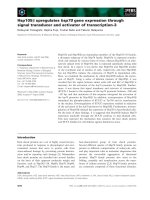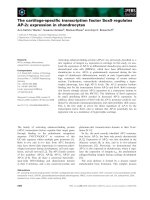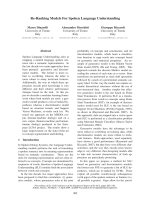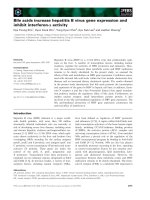báo cáo khoa học: "The in Southern African Nguni cattle. identification, occurrence and origin of the translocation" pot
Bạn đang xem bản rút gọn của tài liệu. Xem và tải ngay bản đầy đủ của tài liệu tại đây (686.33 KB, 10 trang )
A
1/29
chromosome
translocation
in
Southern
African
Nguni
cattle.
The
identification,
occurrence
and
origin
of
the
translocation
N.D.
NEL
E.J. HARRIS
J.E.
WEIERMANS
E.H.H.
MEYER
K.
BRIX
=’=
Animal
and
Dairy
Science
Research
Institute,
Private
Bag
X2,
Irene,
1675,
Republic
of
South
Africa
**
Department
of
Genetics,
University
of
the
Orange
Free
State,
Bloemfontein,
Republic
of
South
Africa.
Summary
A
1/29
chromosome
translocation
was
found
in
10.2
p.
100
of
a
sample
of
305
Nguni
cattle.
Investigations
into
the
origin
and
spread
of
the
translocation
show
a
familial
inheritance
of
the
anomaly
but
give
no
indication
as
to
the
origin
of
the
translocation.
The
high
incidence
was
achieved
despite
the
associated
infertility
and
absence
of
artificial
insemination
which
raises
the
question
of
a
selective
advantage
in
a
particular
environment.
Normal
and
translocation
hetero-
and
homozygous
cattle
are
being
produced
in
order
to
investigate
this
possibility.
Key
words :
Cattle,
Nguni,
chromosome
abnormality,
translocation.
Résumé
Mise
en
évidence,
fréquence et
origine
de
la
translocation
chromosomique
1-29
dans
le
bétail
Nguni
d’Afrique
du
Sud
La
translocation
chromosomique
1-29
a
été
mise
en
évidence
dans
10,2
p.
100
d’un
échantillon
de
305
têtes
de
bétail
Nguni.
L’étude
de
la
diffusion
de
cette
translocation
montre
un
mode
de
transmission
héréditaire
mais
ne
donne
aucune
indication
sur
son
origine.
Cette
fréquence
élevée
a
été
atteinte
en
dépit
d’une chute
corrélative
de
la
fertilité
et
de
l’absence
d’insémination
artificielle
d’où
la
question
posée
de
l’avantage
sélectif
que
conférait
cette
translocation
dans
un
milieu
particulier.
Des
animaux
normaux
et
des
transloqués
homozygotes
et
hétérozygotes
sont
actuellement
procréés
pour
tester
cette
éventualité.
Mots
clés :
Bovins,
Nguni,
anomalie
chromosomique,
translocation.
I.
Introduction
The
Nguni
cattle
are
the
indigenous
cattle
found
along
the
east
coast
of
Southern
Africa,
parts
of
the
eastern
Transvaal,
Swaziland
and
Kwazulu.
The
word
Nguni
is
the
collective
ethnic
name
for
the
Xhosa,
Zulu
and
Swazi
people
who
were
the
original
owners
of
these
cattle
(E
PSTEIN
,
1971
a).
Nguni
cattle
are
of
medium
build,
cervico-
thoracic
humped
with
crescent
or
lyre
shaped
horns
and
are
classified
as
Bos
indicus
of
the
Sanga
type.
A
prominent
feature
of
the
Nguni
cattle
is
the
variety
of
colour
patterns
found
in
this
breed.
The
high
fertility
and
apparent
tolerance
to
heat
and
a
number
of
diseases
warrants
their
inclusion
into
animal
improvement
schemes
(Nguni
CATTLE
REPORT,
1950).
The
first
such
scheme,
the
Bartlow
Combine
breeding
station,
was
established
in
Kwazulu
on
the
east
coast
of
Southern
Africa
in
1950,
while
a
second
farm,
stocked
with
cattle
from
Bartlow
Combine,
was
developed
in
the
Transvaal
in
the
late
1970’s.
These
herds
number
approximately
1
800
and
350
animals
respectively.
It
was
during
an
investigation
into
gonadal
hypoplasia,
present
in
these
herds,
that
a
heterozygous
1/29
chromosome
translocation
was
found
in
a
Nguni
heifer
(M
EYER
,
1981).
).
This
translocation
is
the
same
as
that
which
has
been
described
in
more
than
40
breeds
in
various
countries
of
the
world
(G
USTAVSSON
,
1979).
Investigations
by
G
USTAVSSON
(1969,
1971
a),
R
EFSDAL
(1976),
D
YRENDAHL
&
G
USTAVSSON
(1979),
and
K
OVACS
&
CsuKI,Y
(1980)
show
a
reduction
in
the
fertility
of
translocation
carrying
cattle
in
comparison
to
normal
cattle
under
similar
conditions.
These
results
are
indirectly
supported
by
G
USTAVSSON
(1971
b),
KING
&
L
INARES
(1983)
and
S
WARTZ
&
VOG
T
(1983)
who
found
1/29
translocation
carriers
in
samples
of
repeat
breeder
heifers.
The
reduced
fertility
of
translocation
carriers
is
caused
by
the
production
of
unbalanced
gametes
(L
OGUE
&
H
ARVEY
,
1978 ;
P
OPESCU
,
1978)
and
the
associated
loss
of
aneuploid
embryos
in
an
early
stage
of
pregnancy
(KING
et
al.,
1980 ;
P
OPESCU
,
1980).
Conversely,
studies
by
P
OLLOCK
&
B
OWMAN
(1974),
Q
UEINNEC
et
al.
(1974),
BL
A’
ZAK
&
E
LDRIDGE
(1977),
Z
AHNER
et
al.
(1979),
and
S
TRANZINGER
et
al.
(1981)
fail
to
show
significant
differences
between
the
fertility
of
normal
and
translocation
carrying
cattle.
The
different
results
may
be
attributed
to
the
genetic
control
of
meiotic
segregation
and
selection
against
aneuploid
gametes
in
translocation
heterozygotes
(B
LAZAK
&
E
LDRIDGE
,
1977),
or
to
the
sample
size,
location
and
management
of
the
cattle
under
investigation,
the
method
used
and
the
interpretation
of
the
results
(KovAcs
&
CsuKLY,
1980).
Despite
these
differences,
most
authors
are
in
favour
of
the
removal
of
translocation
carrying
cattle
from
stud
herds.
The
aim
of
this
study
was
to
investigate
the
origin,
identification
and
occurrence
of
the
translocation
in
the
2
Nguni
herds.
The
discussion
also
speculates
on
the
possibility
of
a
selective
advantage
for
translocation
carrying
cattle.
II.
Materials
and
methods
The
bulk
of
the
Nguni
cattle
used
in
this
study
is
located
on
the
Animal
and
Dairy
Science
Research
Institute’s
farm
near
Groblersdal
in
the
Transvaal,
a
province
of
the
Republic
of
South
Africa.
The
remaining
samples
were
obtained
from
the
Bartlow
Combine
breeding
station
in
Kwazulu.
Metaphase
spreads
were
obtained
from
whole
blood
lymphocyte
cultures
adapted
from
the
method
described
by
M
OORHEAD
et
al.
(1960).
0.5
ml
of
heparinised
blood
was
added
to
10
ml
of
culture
medium
(M
150
or
F
10)
supplemented
with
20
p.
100
foetal
calf
serum
and
Concanavaline
A
(0.01
mg/ml
of
culture).
Cultures
were
incubated
for
72
hours
at
37.5
°C
and
Colcemid
(0.005
u.g/ml)
was
added
1.5
hours
prior
to
harvesting.
After
a
hypotonic
shock
with
6
ml
of
0.075
M
KCL
solution
(15
minutes)
the
lymphocytes
were
fixed
in
two
changes
of
Carnoy’s
fixative
(methanol :
acetic
acid,
3 : 1).
Slides
were
prepared
by
dropping
the
cell
suspension
on
to
cold,
wet
microscope
slides,
flamed
or
air
dried
and
rinsed
in
distilled
water.
The
mounted
chromosome
spreads
were
stained
routinely
in
5
p.
100
Giemsa
and
20
well
dispersed
metaphase
spreads
were
studied
for
structural
or
numerical
aberrations.
The
co-ordinates
and
chromosome
counts
of
each
spread
were
recorded.
In
this
way,
a
total
of
305
cattle
(Groblersdal :
217
and
Bartlow
Combine :
88)
were
studied.
The
Groblersdal
sample,
collected
over
a
period
of
3
years
(1981-1983),
included
all
animals
introduced
and
produced
on
the
farm
prior
to
the
discovery
and
removal
of
translocation
carrier
animals
from
the
stud
herd.
The
Bartlow
Combine
sample
of
20
bulls
and
68
cows
was
taken
at
random
from
the
stud
herd
(tabl.
1).
The
chromosomes
of
animals
found
to
deviate
from
the
standard
karyotype
were
identified
by
means
of
G-
and
R-banding
techniques.
C-banding
was
used
to
gain
information
about
the
centromeric
structure
of
the
translocation
chromosome.
G-banding :
2
week
old
slides
were
immersed
in
0.25
p.
100
trypsin
in
Balanced
Salt
Solution
for
30
to
40
seconds
at
room
temperature.
The
trypsin
solution
was
adjusted
to
pH
8.0
with
5
p.
100
sodium
bicarbonate.
After
trypsinization,
the
slides
were
dehydrated
through
a
series
of
alcohol
grades,
air
dried
and
stained
in
5
p.
100
Giemsa.
R-banding
was
obtained
by
exposing
the
cultures
to
5’-Brdu
(50
[t
g/ml)
for
5
hours
prior
to
harvesting.
The
air
dried,
rinsed
slides
were
passed
through
a
series
of
alcohol
grades
to
water,
rinsed
in
phosphate
buffer
and
stained
in
acridine
orange
for
15
minutes.
After
rinsing
for
30
minutes,
the
cells
were
mounted
in
a
drop
of
buffer
and
sealed
with
nail
varnish.
Banded
metaphase
spreads
were
photographed
with
Zeiss
Epi-
fluorescence
equipment
on
Agfaortho
35
mm
film.
C-banding :
2
week
old
slides
were
placed
in
0.2
N
HCI
for
1
hour
and
then
transferred
to
a
5
p.
100
BaOH
solution
(50 °C}
for
periods
ranging
from
1
to
5
minutes.
After
rinsing,
the
slides
were
incubated
for
1
hour
in
2
SSC
(65 °C),
rinsed
in
water
and
stained
in
5
p.
100
Giemsa
for
20
minutes.
The
pedigree
of
each
translocation
carrier
was
traced
in
order
to
gain
information
concerning
the
origin
and
spread
of
the
translocation
and
to
check
the
possible
de
novo
occurrence
of
such
a
translocation.
Only
animals
with
a
carefully
documented
ancestry
were
used
in
the
combined
pedigree.
At
Groblersdal,
translocation
carrier
cattle
were
removed
from
the
stud
herd
and
placed
in
a
separate
translocation
breeding
herd
established
towards
the
end
of
1982.
These
results
will
be
published
at
a later
date.
m.
Results
Screening
of
the
metaphase
spreads
confirmed
the
presence
of
60
chromosomes,
consisting
of
29
acrocentric
autosomal
pairs
and
1
pair
of
sex
chromosomes.
This
is
in
agreement
with
the
findings
of
numerous
authors,
the
earliest
of
whom
used
histological
and
squash
techniques
to
study
cattle
chromosomes
(K
R
nr.
L
irrGER,
1927 ;
MAKING,
1944 ;
M
ELANDER
,
1959).
The
female
is
represented
by
a
pair
of
large
submetacentric
X
chromosomes
while
the
Nguni
bull
has
an
X
chromosome
and
a
small
submetacentric
Y
chromosome.
Karyotypes
of
Giemsa
stained
autosomes
were
arranged
according
to
the
relative
lengths
of
the
chromosomes.
The
G-banded
chromosomes
were
arranged
according
to
the
standard
karyotypes
adopted
at
the
Reading
Conference
(FORD
et
al.,
1980).
The
R-banded
chromosomes
were
arranged
according
to
the
proposals
of
Di
B
ERARDINO
&
Inrrrruzzi
(1982)
and
P
OPEscu
et
al.
(1982).
The
differential
staining
of
the
chromosomes
facilitates
the
identification
of
the
homologous
chromosome
pairs.
The
G-banding
results
were
generally
very
poor.
The
chromosomes
are
either
devoid
of
bands
or
have
an
indistinct
fuzzy
appearance,
both
of
which
make
identification
impossible.
R-banding,
on
the
other
hand,
proved
to
be
a
more
reliable
method,
giving
good
results
(fig.
1).
Enlargement
of
the
R-banded
chromosomes
enables
the
identification
of
the
participating
chromosomes
as
numbers
1
and
29.
The
C-banded
metaphase
spread
(fig.
2)
shows
the
centromeric
regions
of
the
translocation
chromosomes.
These
chromosomes
appear
to
be
monocentromeric
under
the
light
microscope.
Differences
in
the
number
of
chromosomes
per
metaphase
spread
led
to
the
discovery
of
heterozygous
1/29
chromosome
translocations
in
a
number
of
animals.
A
total
of
305
cattle
were
screened.
The
incidence
of
the
translocation
in
the
nucleus
herds
at
Groblersdal
and
Bartlow
Combine
was
found
to
be
9.7
p.
100
and
11.4
p.
100
respectively,
giving
an
average
of
10.2
p.
100
for
all
Nguni
cattle
screened
(tabl.
2).
No
translocation
homozygous
animals
were
found
in
this
sample.
The
translocation,
which
shows
a
familial
pattern
of
inheritance,
has
been
traced
to
2
bulls
(D
230
and
I 234)
present
at
the
establishment
of
the
Kwazulu
herd
in
the
late
1940’s
(fig.
3).
It
is
possible
that
these
bulls
were
related.
No
breeds
other
than
Nguni
have
been
introduced
into
the
herd
since
that
time
and
one
can
only
speculate
on
the
origin
and
spread
of
the
translocation
in
the
Nguni
cattle.
Discussion
The
present
study
shows
both
a
familial
pattern
of
inheritance
and
a
monocentro-
meric
translocation
chromosome.
No
de
novo
occurrences
have
been
found
in
either
of
the
2
Nguni
herds.
These
findings
suggest
an
ancestral
introduction
of the
transloca-
tion
from
a
point
of
origin,
possibly
central
Europe
(H
ARVEY
,
1972 ;
N
IEBUHR
,
1972 ;
Gus
T
AvssoN,
1979).
From
Europe,
translocation
carrying
cattle
could
have
reached
Central
and
Southern
Africa
as
early
as
1 000
A.D.
(E
PSTEIN
,
1971
b).
Another
possibility
is
the
introduction
of
translocation
carrying
cattle
to
Southern
Africa
by
the
Dutch
and
other
European
Settlers
after
1652.
The
study
of
the
banded
and
Giemsa
stained
metaphase
spreads
revealed
the
presence
of
a
1/29
chromosome
translocation
in
10.2
p.
100
of
the
305
Nguni
cattle
studied.
This
relatively
high
incidence
was
attained
despite
the
total
absence
of
artificial
insemination
and
the
adverse
effect
on
fertility
which
has
been
shown
in
extensive
field
(GusTAVSSOrr,
1969 ;
R
EFSD
AL,
1976)
and
cytological
studies
(Kirro
et
al.,
1980 ;
P
OPESCU
,
1980).
The
rationale
for
this
is
the
chance
selection
of
translocation
carrying
bulls
as
sires
in
a
herd
of
restricted
size.
A
second
possibility
is
that
of
a
selective
advantage
in
a
particular
environment.
If
such
an
advantage
does
exist,
it
could,
depending
on
its
nature,
be
of
great
economic
importance.
Testing
the
validity
of
this
hypothesis
requires
a
complete
morphological
and
physiological
comparison
between
normal
and
translocation
hetero-
zygous
and
homozygous
cattle,
a
study
which
is
presently
underway.
In
conclusion
it
may
be
said that
the
1/29
chromosome
translocation
found
in
the
Nguni
cattle
is
of
unknown
origin,
has
a
familial
pattern
of
inheritance
and
is
present
in
approximately
10
p.
100
of
the
Nguni
cattle
screened.
Received
October
8,
1984.
Accepted
February
27,
1985.
Acknowledgements
We
thank
the
Department
of
Co-operation
and
Development
(Rep.
S.
Afr.)
and
the
Kwazulu
Government
Service
for
their
assistance.
We
also
thank
Drs.
C.Z.
Roux
and
J.S.J.
K
RUGER
and
Messrs.
M.M.
SC
HOLTZ,
J.C.
GRO
ENE
WALD,
C.B.
E
NSLIN
and
K.
R
AMSEY
for
their
contribution
to
this
study.
This
paper
forms
part
of
an
M.Sc.
Thesis
submitted
to
the
University
of
the
Orange
Free
State,
Bloemfontein,
Rep.
South
Africa,
1984.
References
B
LAZAK
W.F.,
E
LDRIDGE
F.E.,
1977.
A
Robertsonian
translocation
and
its
effect
upon
fertility
in
Brown
Swiss
cattle.
I.
Dairy
Sci.,
60,
1133-1142.
Di
B
ERARDINO
D.,
l
ANNUZZ
i
L.,
1982.
Detailed
description
of
R-banded
bovine
chromosomes.
1.
Hered.,
73,
434-438.
D
YRENDAHL
I.,
GusTAvssoN
L,
1979.
Sexual
functions,
semen
characteristics
and
fertility
of
bulls
carrying
the
1/29
chromosome
translocation.
Hereditas,
90,
281-289.
E
PSTEIN
H.,
1971
a.
The
origin
of
domestic
animals
of
Africa.
461
pp.,
Africana
Publ.
Corp.,
N.Y.,
London,
Munich.
E
PSTEIN
H.,
1971
b.
The
origin
of
domestic
animals
of
Africa.
545
pp.,
Africana
Publ.
Corp.,
N.Y.,
London,
Munich.
FORD
C.E.,
P
OLLOCK
D.L.,
G
USTASSON
L,
1980.
Proceedings
of
the
First
International
Conference
for
the
standardisation
of
banded
karyotypes
of
domestic
animals.
Hereditas,
92,
145-162.
G
USTAVSSON
L,
1969.
Cytogenetics,
distribution
and
phenotypic
effects
of
a
translocation
in
Swedish
cattle.
Hereditas,
63,
68-169.
G
USTAVSSON
L,
1971
a.
Culling
rates
in
daughters
of
sires
with
a
translocation
of
centric
fusion
type.
Hereditas,
67,
65-74.
G
USTAVSSON
1.,
1971
b.
Chromosomes
of
repeat-breeder
heifers.
Hereditas,
68,
331-332.
G
USTAVSSON
L,
1979.
Distribution
and
effect
of
the
1/29
Robertsonian
translocation
in
cattle.
J.
Dairy
Sci.,
62,
825-835.
H
ARVEY
M.J.A.,
1972.
Chromosome
abnormalities
of
cattle
in
Britain.
Vet.
Rec.,
91,
630.
KING
W.A.,
L
INARES
T.,
1983.
A
cytogenetic
study
of
repeat-breeder
heifers
and
their
embryos.
Can.
Vet.
J.,
24,
112-115.
KING
W.A.,
L
INA
R
ES
T.,
GUSTAVSSON
L,
BANE
A.,
1980.
Presumptive
translocation
type
trisomy
in
embryos
sired
by
bulls
heterozygous
for
the
1/29
translocation.
Hereditas,
92,
167-169.
KovAcs
A.,
CsuKLY
S.,
1980.
Effect
of
the
1/29
translocation
upon
fertility
in
Hungarian
Simmental
cattle.
Proc.
4th
Eur.
Colloq.
Cytogenet.
Domest.
Anim.,
Uppsala,
June
10-13,
1980,
35-43.
K
RALLINGER
H.F.,
1927.
Uber
die
Chromosomenforschung
in
der
Saugetierklasse.
Anat.
Anz.,
63,
209-214.
(Erganzungsheft).
L
OGUE
D.N.,
H
ARVEY
M.J.A.,
1978.
Meiosis
and
spermatogenesis
in
bulls
heterozygous
for
a
presumptive
1/29
Robertsonian
translocation.
J.
Reprod.
Fert.,
54,
159-165.
M
AKINO
S.,
1944.
Karyotypes
of
domestic
cattle,
Zebu
and
domestic
water
buffalo.
Cytologia,
13,
247-264.
M
ELANDER
Y.,
1959.
The
mitotic
chromosomes
of
some
cavicorn
mammals
(Bos
taurus
L.,
Bison
bonasus
L.,
Ovis
aries
L.).
Hereditas,
45,
649-664.
M
EYER
E.H.H.,
1981.
Die
waarde
van
chromosomal
en
biochemiese
genetiese
merkers
vir
diereproduksie.
Tegnikon,
29
(3/4),
8-12.
M
OORHEAD
P.S.,
NOWEL
L
P.C.,
MELLMAN
W.J.,
BATTIPS
D.N.,
HUNGERFORD
D.A,
1960.
Chromosome
preparations
of
leukocytes
cultured
from
human
peripheral
blood.
Exp.
Cell
Res.,
20,
613-615.
N
GUNI
CATTLE
REPORT,
1950.
Report
on
indigenous
cattle
in
South
Africa.
Dept.
of
Agric.,
Union
of
South
Africa,
22,
Bulletin
311.
N
IEBUHR
E.,
1972.
Dicentric
and
monocentric
Robertsonian
translocation
in
man.
Human-
genetik,
16,
217-226.
P
OLLOCK
D.L.,
B
OWMAN
J.C.,
1974.
A
Robertsonian
translocation
in
British
Friesian
cattle.
J.
Reprod.
Fert.,
40,
423-431.
P
OPESCU
C.P.,
1978.
A
study
of
meiotic
chromosomes
in
bulls
carrying
the
1/29
translocation.
Ann.
Biol.
Anim.
Bioch.
Biophys.,
18,
383-389.
P
OPESCU
C.P.,
1980.
Cytogenetics
study
on
embryos
sired
by
a
bull
carrier
of
1/29
trans-
location.
Proc.
IVth
Eur.
Colloq.
Cytogenet.
of
Domest.
Anim.,
Uppsala,
June
10-13,
1980,
182-186.
P
OPESCU
C.P.,
R
ONNE
M.,
C
RIBIU
E.P.,
BoscHER
J.,
1982.
The
standardisation
of
the
R-banded
karyotype
in
cattle
(Bos
taurus
L.).
Proc.
Vth
Eur.
Colloq.
on
Cytogenet.
of
Domest.
Anim.,
Milano-Gargnano,
June
7-11,
1982,
172-190.
Q
UEINNEC
G.,
D
ARRE
R.,
BERL
AND
H.M.,
RAYNAUD
J.C.,
1974.
Etude
de
la
translocation
1/29
dans
la
population
bovine
du
Sud-Ouest
de
la
France :
consequences
zootechniques.
Proc.
Ist
World
Congr.
Genet.
appl.
Livestock
Prod.,
Madrid,
October
7-11,
1974,
3,
131-151.
R
EFSDAL
A.O.,
1976.
Low
fertility
in
daughters
of
bulls
with
1/29
translocation.
Acta
Vet
Scand.,
17.
190-195.
S
TRANZINGER
G.,
E
MLER
K.,
BAUER
G.,
G
AI
LLAR
D
C.,
1981.
Konzeptionsergebnisse
bei
Mischspermaeinsatz
von
Stieren
verschiedener
Rassen
und
Chromosomenzahl.
Zucht-
hygiene,
16,
49-53.
S
WARTZ
H.A.,
VoGT
D.W.,
1983.
Chromosome
abnormalities
as
a
cause
of
reproductive
inefficiency
in
heifers.
J.
Hered.,
74,
320-324.
Z
AHNER
B.,
K
UPFER
U.,
T
SCHUDI
P.,
1979.
Der
Einfluss
der
1/29
translocation
auf
die
Fruchtbarkeit
von
Simmentaler
Kuhen
in
der
Schweiz.
Zuchtghygiene,
14, 49-54.









